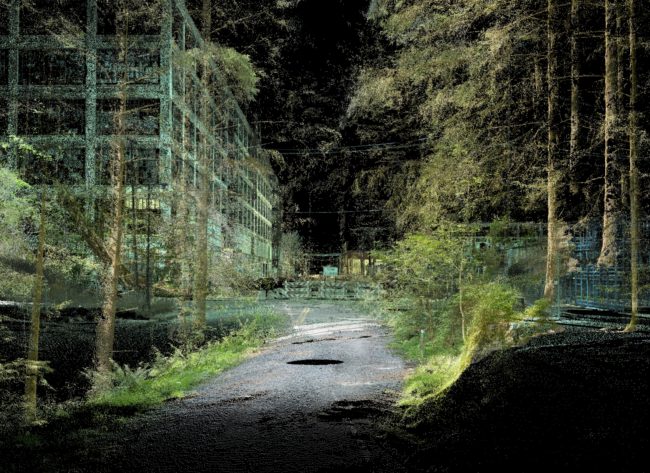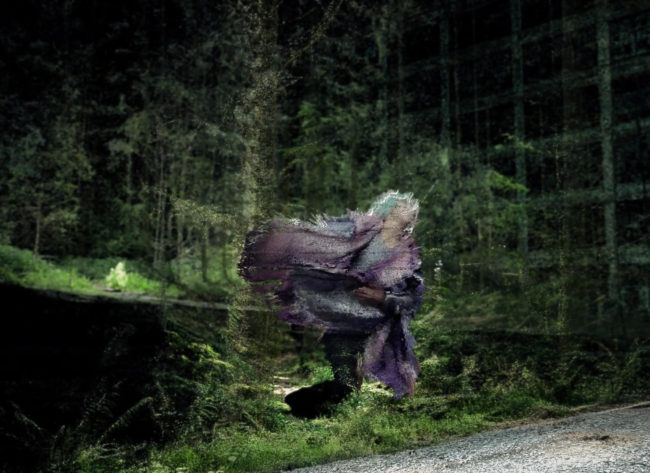The act of seeing – and being seen
Fri 09 Dec 2016In November 2016 AND presented The Invisible City: The Cinema of Surveillance, a programme of film screenings and artist-led tours, delivered in collaboration with Heart of Glass, taking place on the site of the former Pilkington Glass HQ, in St Helens (UK).
Responding to the site and its history of glass manufacturing, we curated a programme of films which explored themes of transparency and visibility, questioning the act of seeing, the role of the voyeur and the pervasive nature of surveillance.
The programme featured Hollywood classics and lesser-known independent films, screened in both private and public areas of the historic site. A series of intimate screenings in the former Pilkington Directors Board Room preceded the main event – when the site’s central courtyard was transformed into an outdoor cinema, viewed from cars and through the myriad of windows that wrap the building.
The main event also featured the world premiere of Where the City Can’t See, a new short film co-commissioned by AND, directed by speculative-architect Liam Young, and written by author Tim Maughan. The first fiction film shot entirely through laser scanning technology, the film is set in a not-too-distant future where Google maps, urban management systems and CCTV are not only mapping our cities, but ruling them.
Shot on location in Grizedale Forest (UK) during AND Festival 2015, and in Detroit (US) throughout 2016, the film follows a group of characters as they traverse the smart city in search of a place they know exists – but that the map doesn’t show. They hack the city and journey through a network of stealth buildings, ruinous landscapes, ghost architectures, anomalies, glitches and sprites, searching for the wilds beyond the machines.

In the text below, director Liam Young shares more about the world of the film and the history and context it references:
The computer vision systems of Google maps, urban management systems and CCTV surveillance are now fundamentally reshaping urban experience and the cultures of our city. Yet we have always found the eccentric and imaginary in the spaces the city can’t see.
Detroit, once America’s Motor City, became the first great relic of capitalist civilization. The birthplace of the modern automobile and the Fordist model of production line-based manufacturing, it transformed not just the US but the whole world. But by the end of the twentieth century it was a wasteland. The US car industry died as it failed to respond to new markets and demands, and car manufacturing shifted overseas to Japan, then China, Korea, India, and beyond. A mass migration out of the city happened for those that could afford to go, leaving a city built for a population of two million with less than 700,000 residents. A population displaced by robots and globalization. A ghost city, where the monuments of the birthplace of global industries were crumbling into dust, and nature started to reclaim the land. The first archeological ruins of Fordist capitalism in city-sized form.
But from out of these ruins rose a global movement: Detroit Techno. An underground scene that reinvented how the world listened to, enjoyed, understood, made, and distributed music. Made by a small group of pioneers – the children of those displaced by Japanese manufacturing – they seized upon Japanese electronics to create a unique new sound, finding hidden places amongst the ruins to party and congregate. Rapidly it spread from Detroit via the emerging new networks of the time to conquer London, Berlin, Tokyo and beyond.

Yet once again Detroit is making cars. But this time they are in Chinese-owned factories. The city has become a Special Economic Zone where the usual laws and regulations controlling labor, automation, and commerce are ignored in the cause of profit. The city is filling up again, as migrant laborers from across the US flood into the city in the hope of finding work. What they find are huge factories built on the ruins of the old, massive worker dormitories, and a Chinese funded smart city that appears to run itself; fully surveilled and automated, where human labor is nothing more than another part in hugely complex network of machines, only existing to do jobs that are still, at least for now, too hard or too expensive to be done by robots. Where workers are just another cog in the self-running, inhuman, sprawling machine that is automated global capitalism.
But in the remaining ruins, the spirit of techno still lives on, hiding from the city in the spaces it can’t see; creating new cultures of escape for the new workers, fighting to remain hidden while preserving the memories and spaces of the Detroit of old.
Recent Journals
- Introducing Commons // Keiken and Jazmin Morris
- Introducing our Creative Associates programme
- Reflections on the Associate Board Member Programme
- The Future of Arts Governance
- Rendering our virtual, net and digital discourses
- Announcing a new partnership between AND and the School of Digital Arts
- Impossible Perspectives 2024
- AND’s new Board Members and Associate Board Members
- Introducing AND’s new Directors
Other Journals
-
2025
-
2024
-
2023
-
2022
-
2021
-
2020
-
2019
-
2018
-
2017
-
2016
-
2015
-
2014
-
2013
-
2012
-
2011




